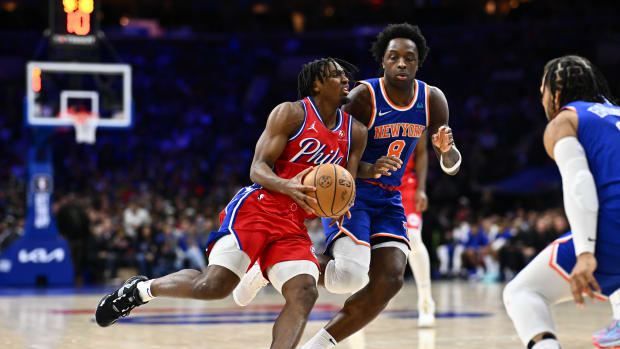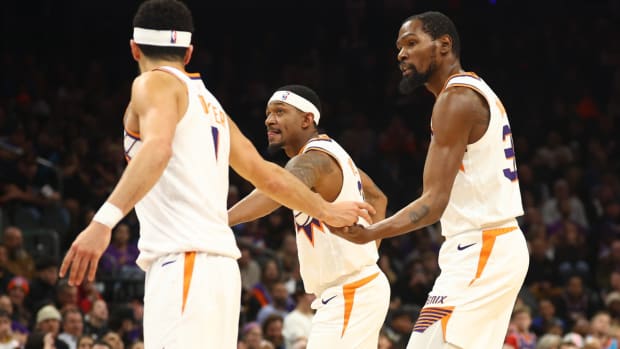
Why Gordon Hayward received a maximum contract offer
In something of an upset, the first big play of free agency is set to come not from the Heat, Rockets, Bulls or Lakers, but the Hornets. Charlotte has reportedly agreed to an offer sheet with Jazz restricted free-agent swingman Gordon Hayward for the maximum: $63 million over four years, sweetened with a player option in the final season and a trade kicker for good measure. Utah, by rule, will have three days to match that offer sheet once it is received. Every report to this point insists that the Jazz will do so and keep Hayward, 24, their first-round pick in 2010.
All of this – particularly the connotations of the "max" label – might seem like an overreach for a merely solid all-round player coming off a trying season. After spending his first three years in strict support of big men Al Jefferson and Paul Millsap, the 6-foot-8 Hayward was pushed into a larger shot-creating role with the Jazz. He responded with career-low shooting percentages (41.3 from the field, 30.4 from three-point range) and career-high turnovers (2.7 per 36 minutes). He was the first-option scorer on a team that ranked 25th in offensive efficiency, his play messy and his skills overextended.
This, in Hayward's case, is what development looks like. Absent the talent that provides a team with a reliable structure, Hayward was left to push on the limits of his game in an attempt to become the star the Jazz needed. He came up as short as his numbers suggest. Hayward is not cut out to be a predominant source of offense, and without the anchoring influence of Jefferson, in particular, his game drifted from equilibrium.
NBA free agency: Grading every deal
Such imbalance should not be confused with regression. Any player thrust into too large a role will naturally see his game compromised, and for Hayward that trade-off came with relative inefficiency. In the 2012-13 season, Hayward created just 31 percent of his own field goals. Last year, that number rose to 50 percent– a significant leap for a player who had been largely used a cutter and spot-up shooter. In the span of a few months, Hayward went from playing off Jefferson, Millsap and veteran guard Mo Williams to essentially manning the point for himself in place of injured rookie Trey Burke.
Burke eventually returned, but Hayward still worked as the ball handler in pick-and-roll situations almost twice as often as he did previously and his number of isolation opportunities increased. Hayward actually improved in both regards: His shooting out of the pick-and-roll, most notably, climbed to 42 percent from 34 percent the previous season, according to Synergy Sports. Though his overall shooting efficiency declined because of the drastic changes in shot type and quality, Hayward progressed in areas targeted for improvement.
NBA free agency: Early market trends
Before last season, Hayward didn't have a great grasp of how to time his move toward the pick in the two-man game, often triggering the action before his screener was properly set. When Hayward was able to find open space, he too often pulled up immediately or dribbled into pressure only to then kill his dribble. There was no rhythm. There was no patience. There was no confidence. All of which is understandable given how infrequently the Jazz worked through Hayward in the pick-and-roll, along with the fact that so many of his attempts to create had come as scraps for offense on possessions gone awry. There was room for Hayward to do more for those Jazz teams, if less still than all he was asked to handle on this latest roster.
That most recent team, it should be noted, ranked 23rd in three-point attempts and 25th in three-point percentage. That's no setting to broaden one's pick-and-roll horizons. To make matters worse, the Jazz lacked the misdirection that keeps the league's best offenses humming, in part because Utah didn't have the talent to make those actions credible. Only so much can be done to make defenses pay attention to Enes Kanter, Marvin Williams or Jeremy Evans as they slide around. As a result, many of Hayward's attempts to create were executed rather bluntly against prepared defenses. Still, Hayward subtly refined his work off the dribble and ability to set up his teammates:
This kind of advancement is slow, gradual and in many ways uncomfortable. But Hayward has the skill to become a more consistent ball-handling presence, if not to the same degree that last year's role demanded. Ideally, a team like Charlotte -- which signed Jefferson last summer -- would put Hayward in a position to leverage both sides of his offensive game: the slow build of his creative talents and his track record as an elite spot-up option. The latter shifted out of phase last season with Utah's lack of shot creation, but in 2012-13 Hayward was one of the NBA's best spot three-point shooters (46.7 percent) while playing for the No. 12 offense.
If allowed to fulfill a more level, natural role, Hayward will thrive. He has a great feel for where to be and when, adding to an offense even when not in control. These are valuable skills, and dual-threat wings who also rebound, cut and defend competitively are a rare breed. Add in Hayward's size and positional flexibility and those ranks grow even smaller.
This is why Hayward will earn the maximum possible salary (almost $15 million) next season – not for the player he was last season or even the year before, but for the amalgamation of both. That's a player worth chasing for the Hornets and one worth matching for the Jazz, overpayment be damned.


































